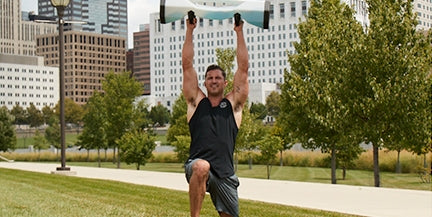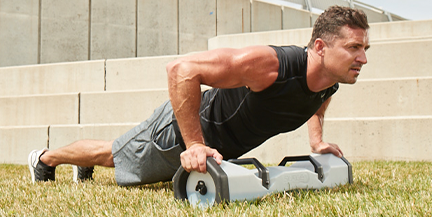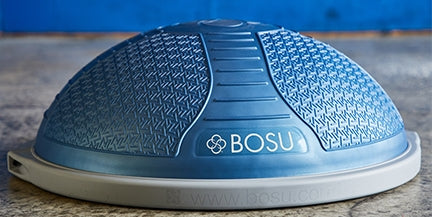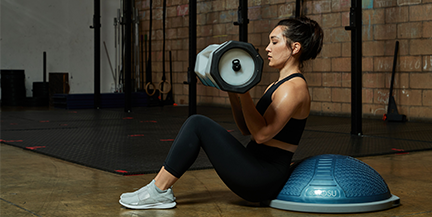Building with Water

How do top athletes and fitness enthusiasts increase their PRs, improve 1-RMs and maintain those gains? The magic lies in understanding the how and why of recovery strategies and accessory training. Make no mistake, reactive water training with the SURGE® Storm can improve your ability to lift heavier loads and decrease your chances for injury.
This is where complementary or accessory exercises come in to play. Be clear! This type of training is not necessarily easy training. Accessory training is focused, efficient and DIFFERENT! “Different” is good. Using the right kind of accessory exercises and training tools can help you improve training results, avoid plateaus, minimize overuse injuries and rev up your gains.
Plus, we all know you can’t lift heavy all the time, so “building with water” is a great way to help you have a more complete and effective approach to your strength training. Current research being completed at San Diego State University (SDSU, 2020) is documenting the importance of training using a water filled product like the SURGE® Storm, and its positive impact on reactivity and timing as it relates to 1) stabilizing muscles “turning on and off,” as well as 2) whole body stabilization, and 3) joint-specific stabilization.
If you’re not clear on the benefits of Hydro-Training with the SURGE® Storm, here you go! Hydro-Inertia® uses the reactive properties of water as the foundation for creating an unstable resistance training tool. Improved stabilization and body control are important outcomes when using water-reactivity to challenge the body with unique and ever-changing stabilization and force production challenges. Hydro-Inertia® requires the musculature and fascia of the body to turn on/off like it does in real life and sport. Unstable SURGE® Storm resistance exercises require greater trunk/joint muscle activation, which translates to greater stabilizing function.
As coaches and trainers, we often approach performance improvement with a direct attack. In other words -- to get gains, to develop strength, to get huge -- we lift heavy loads and bang away religiously at our primary lifts. So yes, that’s part of the puzzle with regard to the mechanics and design of a progressive lifting program. But, equally important is 1) recovery, 2) optimization of adaptive responses and 3) quality of training, which is part of completing the puzzle that leads to “best results.”
An indirect approach, where less is better -- using water loads that are less of an overall absolute load, compared to your normal loads -- is what we’re talking about. But, because water is more reactive and unpredictable when compared to fixed loads, the outcome is, well…DIFFERENT! Not better, not more important, but different. Therein lies the value of Hydro Training. Water training should be part of the mix with regard to a complete approach to strength and fitness training.
Key Point: In other words, you need to build in training time to allow your body to recover, while simultaneously improving another aspect of your strength training program -- reactivity and stabilization.
Ok, so how does this type of training fit into your strength program?
Accessory training and instability resistance training result in a win-win whether you simply want to get fit, perform better in your sport, avoid injury or lift heavier weights.
An important aspect of accessory training exercises and equipment is to lift, or train, with submaximal loads to off-load the body for recovery from heavy lifting protocols, and to simultaneously increase total body stability, body control, and/or to practice similar movement patterns under lighter loading that transfers well to traditional lifts or sport movements.
To be clear, accessory training can be more than simply using the “little” accessory exercises you incorporate that complement your primary lifts. Primary exercises go by a lot of names -- the "big lifts," the "core lifts," the "main lifts" -- all of these terms are often used interchangeably with primary exercises which often include exercises like the squat, deadlift, bench press and clean, etc.
Building with Water: Get Your Gains On
Accessory exercises can be programmed into pre/post workout, post exercise within a workout, or a more aggressive approach may represent an entire workout focused on complementary exercises to drive metabolic response or to improve muscular endurance, balance, mobility, core strength, stabilizing capability, strength or power.
The key is that you’ll be using significantly lighter loads that are unstable, reactive and unpredictable -- the water in the SURGE® Storm.
SURGE® Storm training introduces instability in multi-planar movements that the body must react to and control. In turn, this teaches the body how to stabilize in a timely manner, whether joint specific or total body.
Key Point: By introducing this challenge, you have emphasized the keys to proper positioning and movement mechanics, which lead to performance improvements and a lower risk of injury.
Why should you train with water?
1. Unstable SURGE® Storm resistance exercises require greater trunk/joint muscle activation, which translates to greater stabilizing function.
2. Instability resistance training exercises can also provide training adaptations for coordination and other motor control issues, which has performance implications for any level athlete.
3.Accessory training and instability resistance training results in a win-win whether you simply want to get fit, perform better in your sport, avoid injury or lift heavier weights.
In other words, if you can improve your balance, reactivity and stability capabilities, then strength, power and performance can ALL improve!
SURGE Hang Clean to Overhead Thruster
SURGE Pole Lift to Shoulder Throw
SURGE Core Tuck with Vertical Water Dump
Douglas Brooks, MS, Exercise Physiologist, is the Director of Programming for Hedstrom Fitness, BOSU® and SURGE®. The former Kona Ironman® triathlete directed Athlete Conditioning for Sugar Bowl Ski Academy for 8-years, working with elite junior and professional athletes. Douglas was inducted into the U.S. National Fitness Hall of Fame and has been honored by Can-Fit-Pro as the International Presenter of the Year. Coach Brooks is the author of numerous fitness education books, and most recently, was the recipient of the IDEA Personal Trainer of the Year Award.




